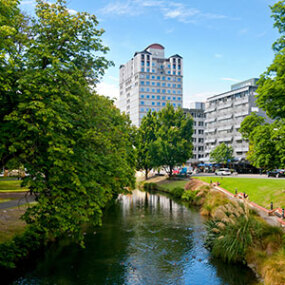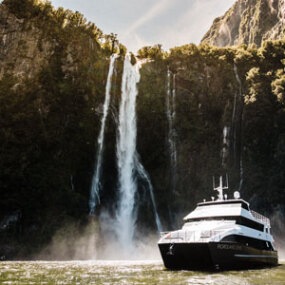Browse other blog categories
- City Experiences (8)
- Articles of Interest (16)
- The Best of New Zealand (26)
- Luxury New Zealand (4)
- South Island Touring (22)
- North Island Touring (13)
- Essential Info (19)
- LOTR, Middle Earth & Hobbits (5)
- Cultural Experiences (8)
- Scenic Trains, Flights & Tours (6)
- Adventure Travel (14)
- Walking, Hiking & Biking (15)
- Family Holidays (10)
- Things to Do (17)
- National Parks & Wildlife (20)
- Food & Wine Experiences (7)
A Guide to Driving in New Zealand
What's different about driving in New Zealand?
You can find out what's different about driving in New Zealand on the Land Transport New Zealand website.
International Driving Licences and Permits
You can legally drive in New Zealand for up to 12 months if you have either a current driver's licence from your home country or an International Driving Permit (IDP). After 12 months you are required to convert to a New Zealand licence. This applies to each visit to New Zealand.
In New Zealand, all drivers, including visitors from other countries, must carry their licence or permit at all times when driving. You will only be able to drive the same types of vehicles you are licensed to drive in your home country. The common legal age to rent a car in New Zealand is 21 years.
Make sure your driver's licence is current. If your licence is not in English, you must bring an English translation with you or obtain an IDP. Contact your local automobile club for further details about obtaining a translation or an IDP.
A translation of your overseas licence or permit can be issued by:
-
the New Zealand Translation Service, or
-
a diplomatic representative at a high commission, embassy or consulate, or
-
the authority that issued your overseas licence (an international driving permit may be acceptable as a translation).
It is important to note that if you are caught driving without an acceptable English translation or an IDP, you may be prosecuted for driving unlicensed or for driving without an appropriate licence and will be liable for an infringement fee of NZ$400 or up to NZ$1,000 on conviction in court.
The Police also have the power to forbid an unlicensed driver to drive until they have an appropriate licence. If you continue to drive after being forbidden, the vehicle you are driving will be impounded for 28 days, at the vehicle owner's expense. You may also risk not being covered by your insurance in the event of a crash.
Road Rules
New Zealanders drive on the left-hand side of the road.
The speed limit is 100km/h on the open road and 40 or 50km/h in urban areas. You will find multi-lane motorways and expressways on the approaches to the larger cities, with most roads being dual carriageways. Signposting follows standard international symbols and all distances are in kilometres (km).
Both drivers and passengers must wear a safety belt in both the front and back seats. All children under the age of eight must be properly restrained by an approved child restraint when travelling in cars or vans.
Get plenty of sleep before a long drive. Take regular breaks – one every two hours and when you get sleepy.
Do not drink alcohol before driving in New Zealand, drinking and driving laws are strictly enforced.
Cycling and Motorbikes
-
Helmets for riders of cycles and motorbikes must be worn at all times.
-
Rear and front lights on cycles are required at night.
-
Motorbikes should drive with a headlight on at all times.
-
Cycling is not permitted on motorways.
For comprehensive information about driving in New Zealand, from road rules to vehicle safety, visit the Land Transport NZ.
Road Safety
Self-driving holidays are one of the most relaxing ways of enjoying New Zealand's landscapes. Many of our roads are scenic and traffic is low when compared to international standards.
Although New Zealand is a relatively small country it can take many hours to drive between cities and other destinations of interest. Even when distances are short, hilly or winding terrain or narrow secondary roads can slow your journey.
If you're used to driving in the city, you should take care when driving on the open country roads. New Zealand has a good motorway system but weather extremes, the terrain and narrow secondary roads and bridges require drivers to be very vigilant.
Never drive if you are feeling tired, particularly after you have just completed a long-haul flight.
The following, general information is provided for your road safety:
-
Always drive on the left-hand side of the road.
-
All road distances are measured in kilometres.
-
When the traffic light is red, you must stop. There is no left turn rule as in North America.
-
The amber traffic light means stop unless you are so close to the intersection you can’t stop safely.
-
The speed limit on the open road is usually 100km/h (approximately 60m/h). In urban areas, the speed limit is 40 or 50km/h. Speed limits are strictly enforced by the police.
-
Drivers and passengers must wear seat belts or child restraints at all times, in both front and rear seats.
-
During long journeys take regular rest and refreshment breaks.
-
Driving under the influence of alcohol or drugs is a crime in New Zealand and strictly enforced by police, with severe penalties for offenders.
-
Refer to Transit New Zealand for countrywide information on New Zealand roads. For up to date information on South Island roads you can also call toll free 0800 4 HIGHWAYS (0800 44 44 49).
Got specific questions about driving in NZ we can help you with? Get in touch now.
Categories:
- Essential Info
Published on: 16 Oct 2017, Written by: David Kettle
We have lots more information to share with you if you need it. Our team lives and works within New Zealand. We have travelled to every region and experienced the best (and worst) of what there is to offer. If you have any questions about tours, locations or just want some friendly advice please reach out to us by chat, email, or phone. There is no penalty for getting in touch, we do NOT charge any consultant fees so you can take the hassle out of your travels for free!
If you are interested in planning a trip then please leave your details in the simple form below and we can provide you with support customising a tour just for you.




